AMD Ryzen 5 3600 Review: Why Is This Amazon's Best Selling CPU?
by Dr. Ian Cutress on May 18, 2020 9:00 AM ESTTurbo, Power, and Latency
Turbo
As part of our usual test suite, we run a set of code designed to measure the time taken for the processor to ramp up in frequency. Recently both AMD and Intel are promoting features new to their processors about how quickly they can go from an active idle state into a turbo state – where previously we were talking about significant fractions of a second, we are now down to milliseconds or individual frames. Managing how quickly the processor fires up to a turbo frequency is also down to the silicon design, with sufficient frequency domains needing to be initialized up without causing any localised voltage or power issues. Part of this is also down to the OEM implantation of how the system responds to requests for high performance.
Our Ryzen 5 3600 jumped up from a 2.2 GHz high-performance idle all the way to 4.2 GHz in 16 milliseconds, which coincides exactly with a single frame on a 60 Hz display. This is right about where machines need to be in order to remain effective for a good user experience, assuming the rest of the system is up to scratch.
Power
With the Ryzen 5 3600, AMD lists the official TDP of the processor as 65 W. AMD also runs a feature called Package Power Tracking, or PPT, which allows the processor to turbo where possible to a new power value – for 65 W processors that new value is 88 W. This takes into account the power delivery capabilities of the motherboard, as well as the thermal environment. The processor can then manage exactly what frequency to give to the system in 25 MHz increments.
As part of my new test suite, we have a CPU power wrapper across several benchmarks to see the power response for a variety of different workloads.
For an AVX workload, y-Cruncher is somewhat periodic in its power use due to the way the calculation runs, but we see an almost constant 90 W peak power consumption through the whole test. The all-core turbo frequency here was in the 3875-3925 MHz range.
Our 3DPMavx test implements the highest version of AVX it can, for a series of six 10 second on, 10 second off tests, which then repeats. In this case we don’t see the processor going above 75 W in the whole process.
Photoscan is our more ‘regular’ test here, comprising of four stages each changing between single thread, multithread, and variable thread. We see peaks here up to 80 W, but the big variable threaded scenario bounces more around the 60 W mark for over 1000 seconds.
On the per-core power side, using our ray tracing power load, we see a small range of peak power values
When one thread is active, it sits at 12.8 W, but as we ramp up the cores, we get to 11.2 W per core. The non-core part of the processor, such as the IO chip, the DRAM channels and the PCIe lanes, even at idle still consume around 12-18 W in the system.
Latency
Our latency test is a simple core-to-core ping test, to detect any irregularities in the core design.
The results here are as expected.
- 7.5 nanoseconds for threads within a core
- 34 nanoseconds for cores within a CCX
- 87-91 nanoseconds between cores in different CCXes


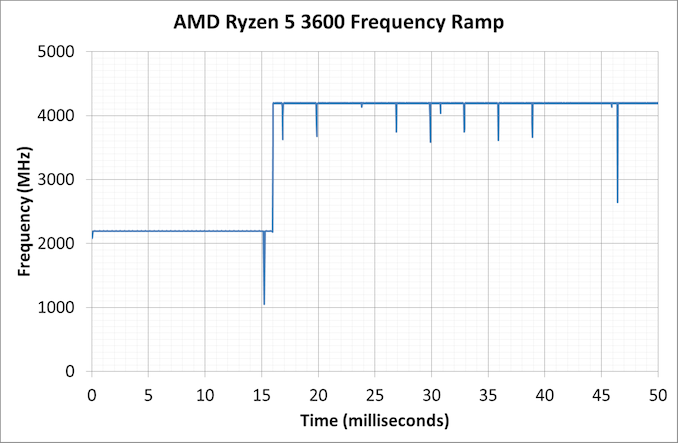
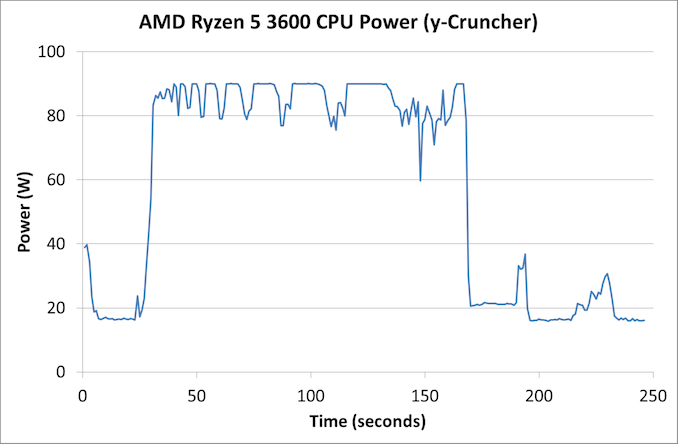
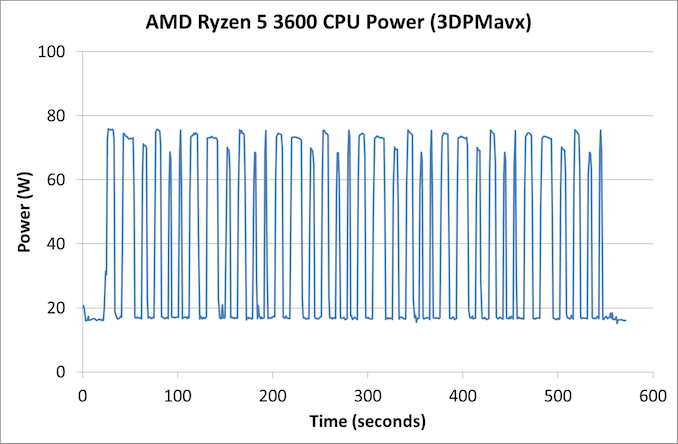
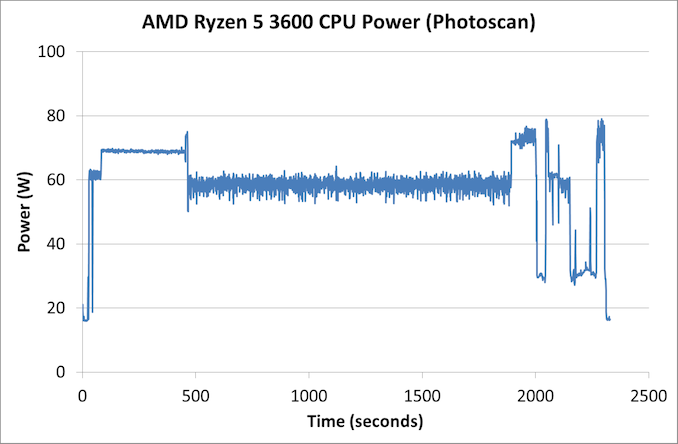
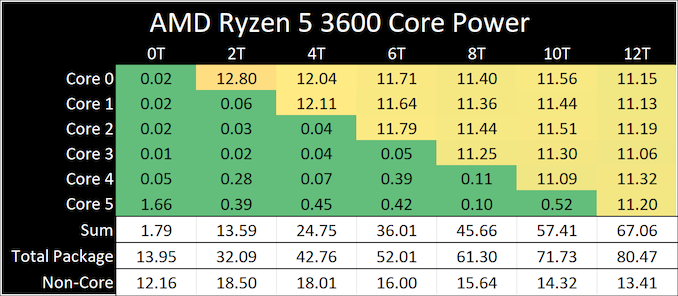
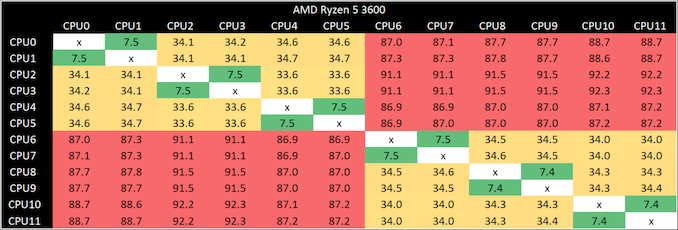








114 Comments
View All Comments
edzieba - Monday, May 18, 2020 - link
The "faster ram" columns always get a good laugh: anyone here running their DIMMs and /not/ using the XMP profiles?WaltC - Monday, May 18, 2020 - link
Right! What would be the point of that?...;) Intel isn't yet equal to AMD in architecture--still needs a bunch of vulnerability mitigation, and is still cranking out 14nm like there's no tomorrow...;) Intel's "high end" is in great demand, says Ian. Hmmm...I'll bet AMD's high end is even under higher demand--since Intel has very little if anything that can catch it. Zen 3 is going to fire another shot across Intel's bow...! Good times!PeachNCream - Monday, May 18, 2020 - link
Yeah, but how many desktop CPUs are getting sold directly to consumers versus the numbers going into more portable form factors or to OEMs for mass market Optiplexes and ProDesks? Those admittedly yawn-fest systems are where the volume sales are landing, not here with Gamer Billy's RGB LED-sled full ATX tower where though there are higher margins on a per-unit basis, the numbers just aren't significant.Icehawk - Wednesday, May 20, 2020 - link
Yeah, I’m not sure why they have a delusional disclaimer saying folks don’t use XML. Last time I checked this was a site for enthusiasts. Would really like them to test at stock and with a reasonable upgrade stick. A wider suite of benchmarks would be nice too.PeachNCream - Monday, May 18, 2020 - link
While the 3600 is currently the best selling desktop CPU on Amazon and it is great to see a competitive CPU landscape right now, occupying that number 1 slot is not representative of the wider PC market as a whole. A vanishingly small number of people elect to operate a desktop PC of any sort these days and of those people the majority do not build their own systems from individual components. Most of the world uses a mobile phone or a laptop to accomplish day-to-day compute tasks and get whatever CPU happens to be included in that system. I'm happy to see 4000-series APUs becoming more available so there is competition FINALLY in the price segments that see large sales volumes. It would be great if Anandtech could get hands on more practical and common hardware that the average person puts to use so the next time I go out to grab a sub-$500 laptop, I know if the cooling is sufficient or if it has dual channel memory. Maybe find out if there is something quirky about the touchpad. I have to drop in at notebookcheck.net most of the time for information that is relevant to me and their reviews are not usually as complete at AT, but AT appears to be very much out of the mobile hardware review business except for halo gamer hardware that relevant to a pretty small audience.WaltC - Monday, May 18, 2020 - link
Maybe it's just the difference in English, but why title the article "Why is the 3600 AMZN's best-selling CPU?" Almost sounds like Ian doesn't think it should be--but then the article itself corrects that misapprehension. Probably a better title would have been, "Here's why the 3600 is AMZN's best-selling CPU." Small change comment--nit picking, for sure...;) IMO, articles should never be titled as questions--a good article should inform, instead of leave unanswered questions. I was always taught that titling with questions instead of statements was second rate. A good article should include the answers--so instead of asking a question you let the reader know, "Herein lies the answer," etc.GreenReaper - Monday, May 18, 2020 - link
It doesn't meet the expectation that any news piece titled with a question can be answered "no", either!Icehawk - Wednesday, May 20, 2020 - link
One title is click bait, one is not. This is the world we live inflyingpants265 - Monday, May 18, 2020 - link
Hello. 3600 is still too expensive. $290 CAD when I paid only $100 CAD for my used 2600. So for me to upgrade, I'd be paying an extra $200.1_rick - Monday, May 18, 2020 - link
Comparing used prices to new isn't very useful.